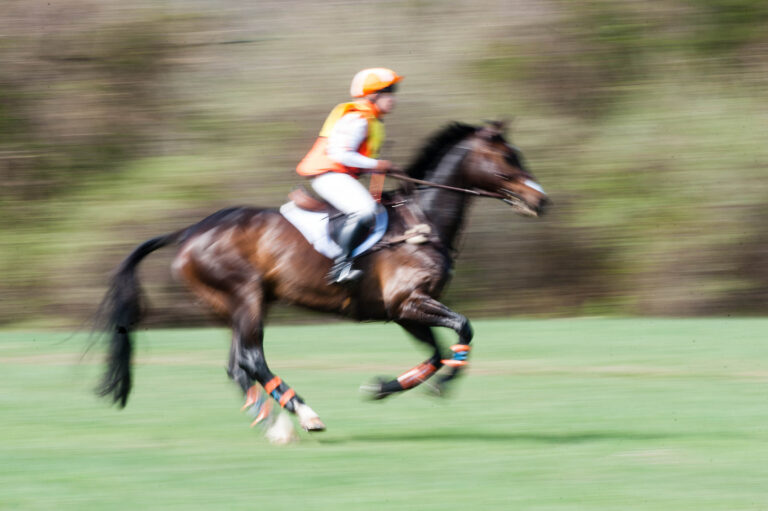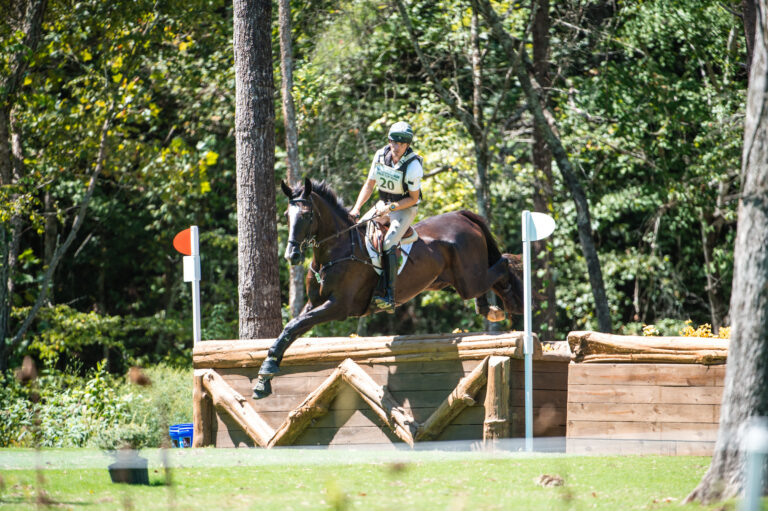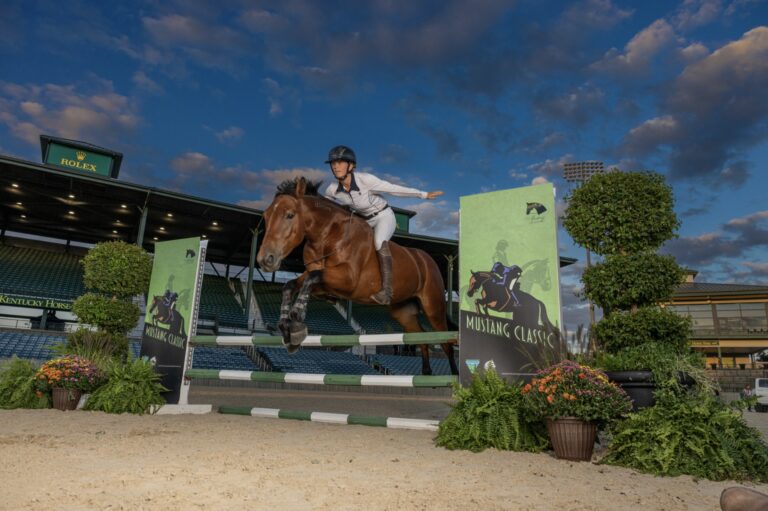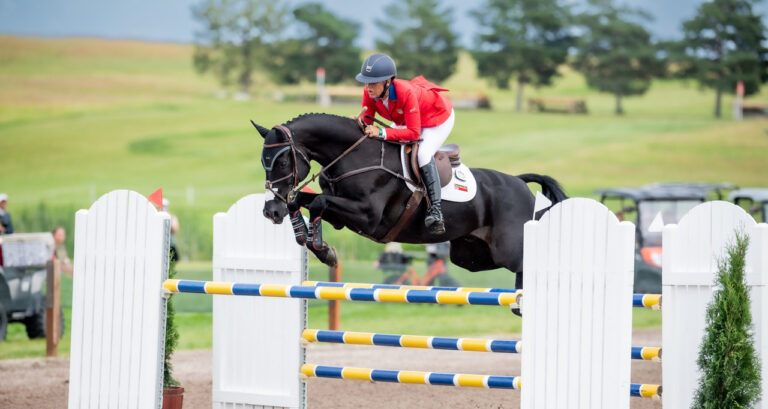Jacqueline Lubrano holds her inside hand out to the side, one of the rider suppling exercises, on Jimmy Torano January 8, 2010 — There probably will be some slightly sore young riders in Wellington, Fla., tomorrow after their “no stirrups” lessons with George Morris on the fourth day of his Horsemastership Training Session this morning.

“Riding without stirrups makes you develop feeling on the horse,” George told the 10 riders, adding that it also makes the horse better accept the aids.
George began the lesson by giving various exercises at the walk and slow sitting trot to supple the riders. “What these exercises do is give you a better seat,” he explained.
The riders started by bridging their reins and holding them in their outside hands. Grasping the pommel with two fingers, they pulled their seats forward and moved their legs back. “This is a position adjustment because our seats slip back and our legs slip forward,” George said.
The exercises they then worked on included:
- dropping their inside hands down by their hips and making several big forward circles with their arms, then backward circles, making sure not to fall forward with their upper bodies.
- taking both legs off their horses, from the crotch down, then putting them back on, like opening and closing scissors.
- holding their inside arms out to the side, then doing a three-part movement: leaning forward with their upper bodies as far as they could go, then sitting on the vertical, then leaning backward as far as they could go. “This gives flexibility to the upper body,” George said.
- riding halt transitions while sitting deep, keeping on their legs and stretching their spines (which is done in every downward transition).
- riding small circles, using slight opening inside reins but being sure to control the horses’ shoulders with the outside reins. “If your horse is sticking a little, a little outside leg at the girth will help turn him.”
- posting to the trot, while holding their inside arms parallel to the ground, being sure to lean forward a bit to stay with the horse’s motion.
The riders did each of these exercises about halfway around the arena, “because they’re quite fatiguing,” George said.
Riders then unbridged their reins as George gave exercises to help supple the horses. As he did yesterday, he insisted the riders build impulsion from the back of their horses to the front while keeping contact and keeping the horses straight through their necks.
“If you don’t have supple joints behind, you have a very stiff horse behind and you have to call the vet. You HAVE to work the horse on his hind legs,” George said. “If you don’t, most of the concussion is on the front legs and you don’t strengthen the loin, the area just in back of the back. It’s a weak area. Horses are built like the Brooklyn Bridge, which my great grandfather helped build. Once a rider sits on the bridge, it further weakens the bridge in the middle. To compensate, we need to bring the middle of the bridge up and strengthen that area. You start this by engaging the hind legs. This drops the croup, it brings up the loin and the back. Most horses at shows have back and joint problems. Most people really don’t want to learn how to work a horse correctly.”
Chase Boggio supples his 13-year-old Dutch Warmblood, Perfekt, with shoulder-in. | ? Sandra Oliynyk The exercises George gave to help correctly work the horses included:

- lengthening the horses’ strides across the diagonal, then sitting deep and shortening their strides when approaching the short side. “You have to feel what is happening in the horse’s mouth,” George said, his voice booming over the microphone. “Not slap on the draw reins so you feel nothing in horse’s mouth.”
- riding shoulder-in, asking the horses to yield with active inside legs and inside reins and holding the outside legs back to limit the bend. “This movement paradoxically helps make your horse go straight,” he said.
- riding transitions to walk but remembering to push. “When I say walk, most people forget about riding. When I say walk, PUSH!”
- riding three progressively smaller circles at the walk. The inside rein is the leading rein, the outside rein is against the neck, the inside leg is at the girth and the outside leg is back. After the last circle, the riders went straight.
- practicing canter departs, of which George had a lot to say. “
Reed Kessler relaxes her hand forward as she asks Mika, her 9-year-old Selle Fran?ais, to lengthen his stride across the diagonal. | ? Sandra Oliynyk Yesterday was a disaster with canter depart. The outside rein is mandatory in the canter depart, not this grotesque neck overbending that is so prevalent today.” To do this, keep the outside leg back as a signal to canter. “This is a very important movement because you have to do on in every class in the horse show . except those with trot fences because they have such ridiculous subterranean fences in some classes at shows these days,” he added, going off on a tangent. “You’re not supposed to have two-foot jumps at shows. You have four-foot jumps.” - riding four to six progressively smaller circles at the canter, then spiraling back out. The outside leg pushes the horse around, the inside leg maintains the impulsion.
- riding flying changes across the diagonal, remembering to lean back and “fix your seat so your horse has to accept your seat. That is garbage what every horse does at the show–bucking, kicking out with the leg when you ask him to change.”
- riding downward transitions, but making sure the horses stay self-active. If the horse slows, “a little attack with both legs,” George said.
- testing that the horses were carrying themselves by riding a 30-foot circle at the trot. George’s instructions: The inside leg is softly pushing the horse to the steady outside rein, which is regulating the horse and turning him. You are taking a feel of the inside rein for three beats, then giving toward the horse’s mouth. The horse should not be leaning. If he is, use a little bit of inside leg. The outside leg is back. You make seven or eight circles, then change direction through the center of the circle.
Jessica Springsteen spirals in with Vornado, her 12-year-old Belgian Warmblood, at the canter. | ? Sandra Oliynyk collecting and lengthening at the canter, then riding a transition to trot and then the free walk, allowing the reins to get progressively longer, but still making sure those hind legs are marching forward so the horses stretch their heads and necks forward and down.
George Morris demonstrates on Jessica Springsteen But George wasn’t just concerned about training. As he excused the first set of riders from the ring, he commented, “What I like about this is you have to walk back to the stable, and it’s a long way. This cools the horse down. They have to be dry. You feel their chests when you go back. Make sure they’re not hot. People, this is a horse sport. What’s interesting is the horse. Not the ribbons, not the accessories. What’s important is the horse and how to best manage him.”

George then displayed his wry sense of humor. As he waited for the second group of riders to come up to the ring, he fumbled with the microphone on his collar saying, “Where’s the microphone man? Come get this off me.” The man started to walk across the arena, but he wasn’t going fast enough and George told him to move faster. Then George chuckled and said, “I’m being my typical obnoxious self, which I love being. I love to be difficult. If I’m not difficult, I’m not happy.”
Tomorrow is the last day of the training session, and the riders will jump a course of several fences.
Read Postcard 1 on gymnastics and Postcard 3 on jumping a course.
Sandra Oliynyk is the editor of Practical Horseman magazine.
Click here to read about rider Zazou Hoffman’s experiences at the training session.
Check out some more photos from the training session on Practical Horseman’sFacebook page.
Read more about the 2010 George Morris Horsemastership Training Session in the March and April 2010 issues of Practical Horseman.
The 2010 George H. Morris Horsemastership Training Session is supported by Purina Mills, Practical Horseman, ASPCA, Equestrian Sports Products, Equus Foundation, Syracuse Invitational Sporthorse Tournament, U.S. Equestrian Federation, USET Foundation and the U.S. Hunter Jumper Association.











